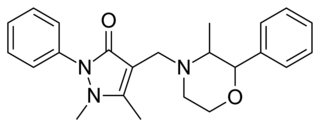
Benzphetamine, sold under the brand name Didrex among others, is an amphetamine-type stimulant and appetite suppressant used short-term for weight loss along with a doctor-approved, reduced-calorie diet, exercise, and behavioral program. It is prescribed for obesity to people who have been unable to lose weight through exercise and dieting alone. It is a prodrug of dextromethamphetamine and dextroamphetamine.

Phenylpropanolamine (PPA), sold under many brand names, is a sympathomimetic agent which is used as a decongestant and appetite suppressant. It was previously commonly used in prescription and over-the-counter cough and cold preparations. The medication is taken by mouth.

Ampyrone is a metabolite of aminopyrine with analgesic, anti-inflammatory, and antipyretic properties. While the parent drug, aminopyrine, has been discouraged due to the risk of agranulocytosis, ampyrone itself has significantly lower toxicity. It is used as a reagent for biochemical reactions producing peroxides or phenols. Ampyrone stimulates liver microsomes and is also used to measure extracellular water.

1,3-Benzodioxolylbutanamine is an entactogenic drug of the phenethylamine, amphetamine, and phenylisobutylamine families. It is the α-ethyl analog of MDPEA and MDA and the methylenedioxy analogue of α-ethylphenethylamine.

11-Hydroxy-Δ9-tetrahydrocannabinol, usually referred to as 11-hydroxy-THC is the main active metabolite of tetrahydrocannabinol (THC), which is formed in the body after Δ9-THC is consumed.

Norcocaine is a minor metabolite of cocaine. It is the only confirmed pharmacologically active metabolite of cocaine, although salicylmethylecgonine is also speculated to be an active metabolite. The local anesthetic potential of norcocaine has been shown to be higher than that of cocaine, however cocaine continues to be more widely used. Norcocaine used for research purposes is typically synthesized from cocaine. Several methods for the synthesis have been described.

Flumequine is a synthetic fluoroquinolone antibiotic used to treat bacterial infections. It is a first-generation fluoroquinolone antibacterial that has been removed from clinical use and is no longer being marketed. The marketing authorization of flumequine has been suspended throughout the EU. It kills bacteria by interfering with the enzymes that cause DNA to unwind and duplicate. Flumequine was used in veterinarian medicine for the treatment of enteric infections, as well as to treat cattle, swine, chickens, and fish, but only in a limited number of countries. It was occasionally used in France to treat urinary tract infections under the trade name Apurone. However this was a limited indication because only minimal serum levels were achieved.

11-Nor-9-carboxy-Δ9-tetrahydrocannabinol, often referred to as 11-nor-9-carboxy-THC or THC-11-oic acid, is the main secondary metabolite of tetrahydrocannabinol (THC) which is formed in the body after cannabis is consumed.

Semustine is an alkylating nitrosourea compound used in chemotherapy treatment of various types of tumours. Due to its lipophilic property, semustine can cross the blood-brain barrier for the chemotherapy of brain tumours, where it interferes with DNA replication in the rapidly-dividing tumour cells. Semustine, just as lomustine, is administered orally. Evidence has been found that treatment with semustine can cause acute leukaemia as a delayed effect in very rare cases.

Epiandrosterone, or isoandrosterone, also known as 3β-androsterone, 3β-hydroxy-5α-androstan-17-one, or 5α-androstan-3β-ol-17-one, is a steroid hormone with weak androgenic activity. It is a metabolite of testosterone and dihydrotestosterone (DHT). It was first isolated in 1931, by Adolf Friedrich Johann Butenandt and Kurt Tscherning. They distilled over 17,000 litres of male urine, from which they got 50 milligrams of crystalline androsterone, which was sufficient to find that the chemical formula was very similar to estrone.

Morazone is a nonsteroidal anti-inflammatory drug (NSAID), originally developed by the German pharmaceutical company Ravensberg in the 1950s, which is used as an analgesic. It produces phenmetrazine as a major metabolite and has been reported to have been abused as a recreational drug in the past.

Cannabis drug testing describes various drug test methodologies for the use of cannabis in medicine, sport, and law. Cannabis use is highly detectable and can be detected by urinalysis, hair analysis, as well as saliva tests for days or weeks.

N,α-Diethylphenethylamine is a close chemical analog of methamphetamine, which has been sold as a designer drug. It was originally patented by Knoll Pharma as one of several analogs for pharmaceutical applications. In animal models these analogs showed properties of cognitive enhancement and increased pain tolerance. Nevertheless, this class of compounds was never developed into a medicine. N,α-DEPEA has not been studied in humans, but experts such as Pieter Cohen of Harvard Medical School expect it to be less potent than methamphetamine, but greater than ephedrine.

NM-2-AI, also known as N-methyl-2-aminoindane, is a drug of the 2-aminoindane group that has been sold online as a designer drug. It is a rigid analogue of methamphetamine. NM-2-AI acts as a selective norepinephrine releasing agent, but also has affinity for several monoamine receptors.

'MDMB-CHMICAa' is an indole-based synthetic cannabinoid that is a potent agonist of the CB1 receptor and has been sold online as a designer drug. While MDMB-CHMICA was initially sold under the name "MMB-CHMINACA", the compound corresponding to this code name (i.e. the isopropyl instead of t-butyl analogue of MDMB-CHMINACA) has been identified on the designer drug market in 2015 as AMB-CHMINACA.

25iP-NBOMe is a derivative of the phenethylamine hallucinogen 2C-iP, which acts as a highly potent agonist for the human 5-HT2A receptor.

19-Nordehydroepiandrosterone (19-nor-DHEA), or 19-nor-5-dehydroepiandrosterone (19-nor-5-DHEA), is an estrane (19-norandrostane) steroid which was never marketed. It is the combined derivative of the androgen/anabolic steroid nandrolone (19-nortestosterone) and the androgen prohormone dehydroepiandrosterone. Related compounds include 19-nor-5-androstenediol, bolandiol (19-nor-4-androstenediol), and bolandione (nor-4-androstenedione), which are all known orally active prohormones of nandrolone. 19-Nor-DHEA may occur as a metabolite of bolandione and related steroids.

11-Hydroxy-Δ-8-tetrahydrocannabinol is an active metabolite of Δ8-THC, a psychoactive cannabinoid found in small amounts in cannabis. It is an isomer of 11-OH-Δ9-THC, and is produced via the same metabolic pathway. It was the first cannabinoid metabolite discovered in 1970.

ADB-BINACA (also known as ADMB-BZINACA using EMCDDA naming standards) is a cannabinoid designer drug that has been found as an ingredient in some synthetic cannabis products. It was originally developed by Pfizer as a potential analgesic, and is a potent agonist of the CB1 receptor with a binding affinity (Ki) of 0.33 nM and an EC50 of 14.7 nM.



















